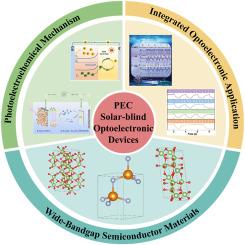Solar-Blind Deep Ultraviolet Photoelectrochemical Detectors: Materials, Mechanisms, and Applications
IF 9.7
2区 材料科学
Q1 MATERIALS SCIENCE, MULTIDISCIPLINARY
引用次数: 0
Abstract
Photodetection technologies underpin a broad range of modern optoelectronic applications, encompassing imaging, communication, environmental monitoring, and biochemical sensing. At the core of these systems lie photodetectors, which transduce optical signals into electrical outputs, thereby defining overall device performance. Among various detection needs, solar-blind ultraviolet photodetectors (SBPDs) hold particular significance due to their intrinsic ability to suppress atmospheric background interference, enabling high-contrast detection in demanding settings such as defense and harsh environment monitoring. However, reliable UVC detection remains technologically challenging, as conventional solid-state devices often suffer from elevated dark current, intricate fabrication processes, and the necessity for external biasing. To overcome these limitations, photoelectrochemical (PEC) architectures present a compelling alternative, offering self-powered operation, structural simplicity, and improved environmental resilience. By leveraging redox reactions at the solid-liquid interface, PEC devices provide strong compatibility with ionic, aqueous, and biologically relevant environments—making them promising candidates for flexible and integrated optoelectronic systems. This review systematically summarizes recent advances in PEC SBPDs, covering fundamental principles, device configurations, and performance metrics. Particular focus is given to wide-bandgap semiconductors, including AlGaN, Ga2O3, and diamond. Finally, we discuss their integration into advanced functional systems and delineate existing challenges and future prospects for real-world implementation.

日盲深紫外光电化学探测器:材料、机制和应用
光探测技术支撑着广泛的现代光电应用,包括成像、通信、环境监测和生化传感。这些系统的核心是光电探测器,它将光信号转换成电输出,从而定义了整个设备的性能。在各种检测需求中,日盲紫外探测器(sbpd)由于其固有的抑制大气背景干扰的能力而具有特殊的意义,可以在国防和恶劣环境监测等苛刻的环境中实现高对比度检测。然而,可靠的UVC检测在技术上仍然具有挑战性,因为传统的固态器件经常遭受高暗电流,复杂的制造工艺和外部偏置的必要性。为了克服这些限制,光电化学(PEC)结构提供了一个令人信服的替代方案,提供自供电操作,结构简单,并提高了环境弹性。通过利用固液界面的氧化还原反应,PEC器件与离子、水和生物相关环境具有很强的兼容性,使其成为柔性集成光电系统的有希望的候选者。本文系统地总结了PEC sbpd的最新进展,包括基本原理、设备配置和性能指标。特别关注宽带隙半导体,包括AlGaN, Ga2O3和金刚石。最后,我们讨论了它们与高级功能系统的集成,并描述了现实世界实现的现有挑战和未来前景。
本文章由计算机程序翻译,如有差异,请以英文原文为准。
求助全文
约1分钟内获得全文
求助全文
来源期刊

Materials Today Physics
Materials Science-General Materials Science
CiteScore
14.00
自引率
7.80%
发文量
284
审稿时长
15 days
期刊介绍:
Materials Today Physics is a multi-disciplinary journal focused on the physics of materials, encompassing both the physical properties and materials synthesis. Operating at the interface of physics and materials science, this journal covers one of the largest and most dynamic fields within physical science. The forefront research in materials physics is driving advancements in new materials, uncovering new physics, and fostering novel applications at an unprecedented pace.
 求助内容:
求助内容: 应助结果提醒方式:
应助结果提醒方式:


